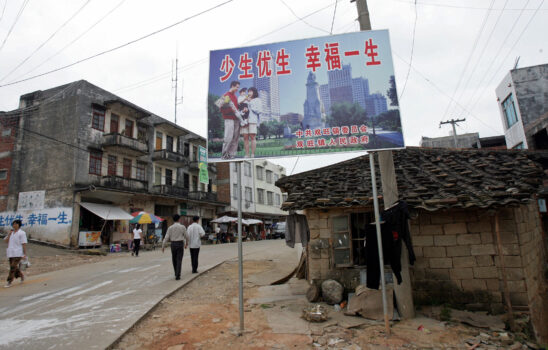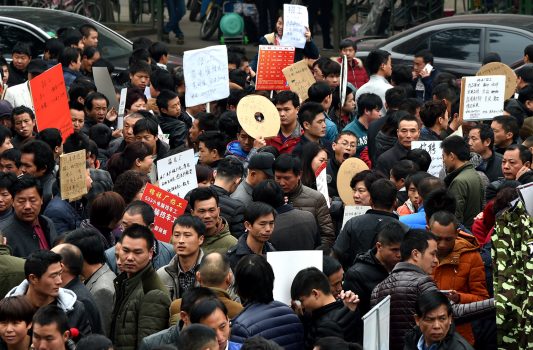
Commentary
After China announced the results of its seventh national census, various criticisms immediately followed, mostly focusing on the serious distortion of facts.
Falsification of statistical data is a systemic disease that has existed in China since the founding of the Chinese communist regime. Before the authorities implemented the one-child policy in 1980, which aroused worldwide criticism, China’s population data was falsified in an under-reported manner because the Chinese authorities believed overpopulation was a headache back then. Now the situation is reversed—population data is still falsified but this time it is inflated.
Falsification is certainly a big problem. Nonetheless, when discussing China’s demographic issues, some analysts have overlooked the real problems.
First of all, population flow from economically underdeveloped areas to urban areas is not unique to China. The real problem is an ill economic structure.
I took a closer look at an issue that has been widely criticized. That is, based on the population in each province, it is obvious that there are more residents in the south and fewer in the north, more in the east and fewer in the west. Some northern and western provinces have already experienced negative population growth, showing a noticeably unbalanced population structure.
South China’s economy is more developed than the north, and the east is more prosperous than the west. Population migration from economically underdeveloped areas to relatively developed areas is a natural trend under the market economy, and this is true all over the world. The northeast has been declining and the west was underdeveloped to begin with, especially the desert areas in the northwest that are not suitable as human habitats. Nowadays, young adults in these areas can relocate to south and east China and they have survived, which not only indicates that the mobility of Chinese society has increased, but also proves that the contemporary youth have better adaptability than their parents’ generation. That is to say, unbalanced population distribution per se is not necessarily a problem.

The same is true in the United States. In recent years, there have been outbound migrations from New York, San Francisco, Chicago, and other cities. The Democratic-controlled states advocate political correctness. For instance, a large number of illegal immigrants moved into these states, BLM protests occur frequently, and taxation is heavy. As a result, many companies have chosen to leave and the economies in these states have declined. Naturally, these companies took away a group of employees, causing a population loss for these states, and the loss is mostly affluent residents.
For China, the key problem, a really serious one, is that the economic structure of China’s underdeveloped areas is abnormal, and many areas are not even financially self-sufficient.
For example, Foping county of Shaanxi Province has recently been hyped by the Chinese media for having a very low permanent population, a little over 8,000 in the entire county, while there are 2,194 people working in the local government and public institutions.
The county’s local fiscal revenue was 39.43 million yuan in 2018 and 36.6 million yuan in 2019. The fiscal expenditures in these two years were 800 million yuan and 797 million yuan respectively. It is a parasitic area that has to feed on the central government. The situation in Foping is somewhat extreme, but in remote Chinese counties, the lack of employment opportunities for local youth is a common phenomenon.
Based on the above analysis, discussing the imbalanced population distribution in China is a seemingly serious topic but a false problem. Due to differences in economic development and geological factors, no country in the world has an evenly distributed population in different regions. Only totalitarian regimes like to control population movement and believe it is normal for the population to be evenly distributed across all regions.
‘Aging Demographics’ With Chinese Characteristics
According to the United Nations standard, a country or region with an elderly population of more than 7 percent can be considered as entering an aging society, 14 percent or more means “moderate aging.”
Currently, the proportion of elderly people aged 65 and over in China has reached 13.5 percent, according to official data. Public opinion has been focused on the discussion that the aging problem is imminent, as if the livelihood problem of China’s elderly population should only be attributed to the excessively large number of seniors.

The United Nations has released a report titled “World Population Prospects: The 2012 Revision,” which forecasts the elderly population of various countries in 2014, 2030, and 2050.
According to the U.N. data, mankind is now in the middle stage of the 2014 to 2030 period.
In 2014, China ranked 52nd with an elderly population accounting for 14.4 percent. In the same year, 96 countries also obtained their national census data, which showed that there were 33 countries in the world where the elderly population exceeded 20 percent.
In the 2030 forecast, among the same 96 countries, China ranked 43rd with an elderly population of 23.8 percent in its total population. By 2030, 14 countries in the world will have more than 30 percent of the elderly population, among them Malta and Slovenia are the only two developing countries.
The countries that have a higher degree of aging population than China are mostly western countries. Only a few are developing countries such as Albania, Argentina, and Montenegro. Conversely, those countries that have a lower percentage of elderly population than China are mostly developing countries.
Among all countries with census records, Japan is facing the most serious aging problem. The elderly population in Japan was 32.8 percent in 2014 and projected to reach 37.5 percent in 2030. In contrast to China, Japan and the European Union countries have all largely solved the problem of taking care of the elderly, even though they have a higher percentage of senior population than that of China.
It can be seen that China’s issue of eldercare does not lie in the problem of an increasingly aging population per se, but the country’s pension and social welfare system, which is a political and economic policy issue. This is especially true when we consider that there are about 77 million elderly people in rural areas, a population group that faces the most serious livelihood problem as they basically have no social welfare such as medical insurance and pension.
Fewer Births Isn’t the Same as the Disappearance of Demographic Dividend
Some people equate declining birth rates with diminishing demographic dividend. It is actually very easy to debunk this statement.
The demographic data of the 96 countries listed by the aforementioned U.N. report showed that the countries with a high proportion of young people were mostly African and Middle Eastern countries, where birth rates were very high, as well as some Asian countries. Brazil, Turkey, Colombia, Venezuela, Peru, South Africa, India, Indonesia, Honduras, Iraq, Pakistan, Jordan, and Bangladesh were all in this category. But it so happens that these countries have the highest youth unemployment rates.
Fewer births/children is a big problem for individual families. It is said that in China, the number of elderly people who lost their only child has exceeded 2 million. As the Chinese traditionally rely on children to care for elderly parents, caring for bereaved parents is a problem that requires the collaborative support of the government and society. But from the perspective of the entire society, fewer births cannot be equated with the disappearance of the demographic dividend. Those who argued otherwise have overlooked a problem: the realization of the demographic dividend requires full or close to full employment of young people.
Ever since China started its “reform and opening up” about 40 years ago, it experienced several phases of rapid employment growth, and naturally realized a demographic dividend to the full extent. The growth in the 1990s was due to the influx of capital from Hong Kong, Taiwan, Japan, and South Korea. China later became the “world’s factory” after joining the World Trade Organization in 2001, and enjoyed a more booming phase in the years that followed.
However, since the 2010s, labor-intensive industries have been gradually moving out of China—its status as the “world’s factory” has begun to wane. It has become increasingly difficult for the youth to find employment, and a large number of them can’t leave the nest and continue to rely on their parents for financial support. The demographic dividend certainly cannot be realized during this time period.

To further illustrate this point, let’s do a simple comparison of the youth unemployment rates in different countries. It will help us understand how significant it was for China to have the demographic dividend it enjoyed in the golden decade from 2002 to 2012.
Youth unemployment is a global problem that has been a serious concern for more than 20 years. In October 2000, the International Labor Organization released the report “Global Employment Trends for Youth,” pointing out that during the 20 years from 1999 to 2019, the youth participation in the labor market dropped by 12 percent, showing a global downward trend; yet the total number of young people increased by 300 million during the same period.
In terms of regional differences, the 2019 youth employment rate was the highest in North America, which was 52.6 percent. North Africa and the Arab region were the lowest at 27 percent. East Asia’s rate was 45.2 percent, higher than the global average of 41.2 percent.
It’s noteworthy that, as I mentioned earlier, these regions where youth employment rates were among the lowest have the highest percentage of young people. In other words, they were the least aging society. However, young people in these regions still do not have adequate employment opportunities, and these countries have also become the main source of refugees flowing into Europe since 2015.
Apparently, a younger demographic structure is only one of the conditions for realizing the demographic dividend, but this condition does not guarantee a good outcome.
In recent years, China’s status as the “world’s factory” is coming to an end, the industrial chain is being reshaped on a global scale, and the modern industrial system is more dependent on automation equipment and specialized skills. Correspondingly, the real problem is not the decline in birth rates, but the quality of the workforce.
Up to now, China is still the world’s most populous country, and it is heavily dependent on imports for major resources. For example, more than 60 percent of oil and 30 percent of food are imported. In terms of resources, it is a very fragile system.
For a country like China, it is extremely important to avoid the Malthusian trap and to treat its population and demographic problem in a rational manner.
He Qinglian is a prominent Chinese author and economist. Currently based in the United States, she authored “China’s Pitfalls,” which concerns corruption in China’s economic reform of the 1990s, and “The Fog of Censorship: Media Control in China,” which addresses the manipulation and restriction of the press. She regularly writes on contemporary Chinese social and economic issues.
Views expressed in this article are the opinions of the author and do not necessarily reflect the views of The Epoch Times.






Be the first to comment